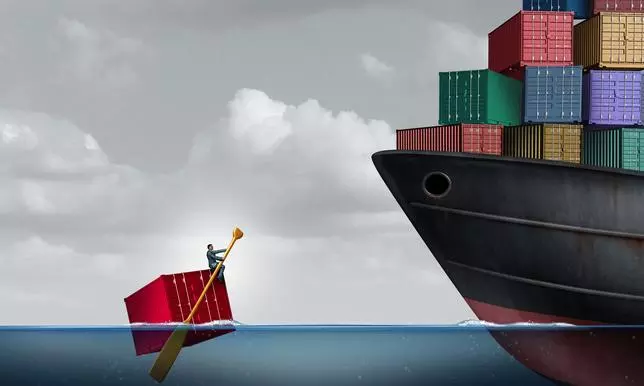
- Home
- India
- World
- Premium
- THE FEDERAL SPECIAL
- Analysis
- States
- Perspective
- Videos
- Sports
- Education
- Entertainment
- Elections
- Features
- Health
- Business
- Series
- In memoriam: Sheikh Mujibur Rahman
- Bishnoi's Men
- NEET TANGLE
- Economy Series
- Earth Day
- Kashmir’s Frozen Turbulence
- India@75
- The legend of Ramjanmabhoomi
- Liberalisation@30
- How to tame a dragon
- Celebrating biodiversity
- Farm Matters
- 50 days of solitude
- Bringing Migrants Home
- Budget 2020
- Jharkhand Votes
- The Federal Investigates
- The Federal Impact
- Vanishing Sand
- Gandhi @ 150
- Andhra Today
- Field report
- Operation Gulmarg
- Pandemic @1 Mn in India
- The Federal Year-End
- The Zero Year
- Science
- Brand studio
- Newsletter
- Elections 2024
- Events
- Home
- IndiaIndia
- World
- Analysis
- StatesStates
- PerspectivePerspective
- VideosVideos
- Sports
- Education
- Entertainment
- ElectionsElections
- Features
- Health
- BusinessBusiness
- Premium
- Loading...
Premium - Events

What matters in a country’s international commercial transactions is the current account balance, not trade surpluses or deficits with individual countries
Tempers are running high in sections of the media over the rise in India’s trade deficit with China to $99 billion for 2024-25. With Hong Kong, the trade deficit is $13.64 billion.
The same commentators who pour scorn over US President Donald Trump’s assertion that countries that run a trade surplus with the US are “ripping us off”, describing, correctly, this notion as economic illiteracy, wax wrathful over China’s export surplus vis-à-vis India. Such passion is misplaced.
Also read: Why India can only grin and bear Trump’s tantrums while China roars back
At the same time, given the tariff hurdles the US has placed on China, Chinese exporters are under pressure to find alternative markets to sell their wares and dump products — that is, sell below the price at which the product is sold at home, to clear inventory. India has to guard against such dumping.
Mobile, pharma exports
What matters in a country’s international commercial transactions is the current account balance, not trade surpluses or deficits with individual countries. Some countries serve as the source point of essential inputs needed for India’s export performance.
Consider mobile phone exports, of which Indians tend to be inordinately proud. In calendar year 2024, India exported a little over $20 billion worth of mobile phones, including iPhones and Samsung models.
What should worry India is if its aggregate current account deficit grows unsustainably large. Of that, there is no sign.
The domestic value addition is, at the most, 20 per cent. In other words, $16 billion worth of imports have been necessary to make those exports of $20 billion. Most of the parts, assemblies and sub-assemblies that go into these exported phones come from China.
Also read | What is bad news for Europe could spell geopolitical cheer for India
India’s pharma exports in the last fiscal year stood at $30 billion, quite an impressive performance. India sources more than a third of the active pharmaceutical ingredients via imports, and 70 per cent of the imports are from China.
India wants to step up solar energy generation massively. The basic photovoltaic cells and panels that go into the modules that are deployed come from China. The more India’s development of renewable energy, the more India’s imports from China.
Huge crude import bill
India, in 2023, was the world’s third-largest exporter of refined petroleum products. The country depends on the import of crude and gas to the tune of 80 per cent of its requirements.
So, India will necessarily run up a huge import bill on crude, to refine it and produce refined products such as aviation turbine fuel, petrol and diesel, for domestic sales and export.
Also read: Why economists expect Trump’s tariffs to punish Americans more than Chinese
India refines the bulk of the imported crude for domestic sale. We will have a huge deficit with the countries from which we import the crude, as the export of the refined products is to Europe, the US and other countries, rather than back to the countries that supplied the crude.
Should India look askance at these imports of crude from countries that cannot buy enough from India to show balanced trade on a bilateral basis?
Aggregate deficit
China is a big buyer of commodities: ores, minerals, soy, and so on, from Asia, Latin America and Africa. The export of commodities to China puts purchasing power in the hands of the source countries.
With that purchasing power, these nations buy goods and services from other countries, including India. India’s export performance, in other words, depends on China’s ability to import things from other countries, convert them into value-added products and export them around the world, including to India.
What should worry India is if its aggregate current account deficit grows unsustainably large. Of that, there is no sign.
At the outset, let us understand that a current account deficit, by itself, is a good thing, especially for a developing country. It means that the economy is absorbing more goods and services than it has produced.
External savings
Specifically, the current account deficit is equal to the excess of domestic investment over domestic saving. How can an economy invest more than it has saved? By drawing in external savings. Savings are what is left over in an economy after consumption.
Also read | India feels the tremors as China plans mega dam, copper mining in Tibet
With those savings, an economy can invest domestically or abroad. When India runs a current account deficit, it imports capital from the rest of the world. The rest of the world is happy to extend that capital to India because it is assured of getting a return on such investment.
External capital deployed in India has to be serviced, whether such capital comes in as equity or debt. If India’s ability to service such capital looks doubtful, as could happen when the current account deficit grows very large, the providers of capital could turn jittery, and try to take their capital back. That would be disruptive.
Moderation in investment
India ran up a current account deficit that looked unsustainable way back in 2012, when it touched 5 per cent of GDP. It shrank to a manageable 2.6 per cent of GDP in 2013, the very next year, and has stayed in the modest territory since, even turning into a surplus in the COVID year of 2020, when there was little economic activity and the economy needed to import little.
In the past couple of years, the current account deficit has been an anaemic 1 per cent of GDP, signalling moderation in investment.
If India grows dependent on China for some goods that cannot be sourced from other countries, the ability to stop supplies of such goods could become strategic leverage in China’s hands.
How do we square this explanation with the current account surpluses accumulated by China, while also investing some 40 per cent of GDP or more at home? This was achieved by squeezing consumption so badly, in relation to what would have been possible without an undervalued currency, that the economy saved half of what it produced, invested most of the savings domestically, and the balance in the rest of the world.
Also read: China urges India to unite against Trump tariff ‘abuse’
Former chairman of the US Federal Reserve, Ben Bernanke, famously blamed China as the prime culprit in a global savings glut that dumped capital in the US government bond market, reduced interest rates to artificially low levels, encouraged profligate lending, including to sub-prime borrowers, and precipitated the trans-Atlantic financial crisis of 2007-09 (the western media calls it the Global Financial Crisis, but the crisis was in the US and Europe, with the rest of the world feeling its impact).
Window of opportunity
China has been grappling with its excess savings, and trying to develop what it calls the internal circulation of goods and services. It has to boost its consumption and reduce its reliance on exports to sustain growth. This will give India an opportunity to export more to China.
India’s overall balance of payments is comfortable, the current account deficit is, if anything, too small, rather than too large. There is no reason to worry about the deficit with China specifically – except in one vital respect.
If India grows dependent on China for some goods that cannot be sourced from other countries, the ability to stop supplies of such goods could become strategic leverage in China’s hands. The way to guard against that is to identify alternative sources, even as India develops domestic capability to produce those vital supplies.
(The Federal seeks to present views and opinions from all sides of the spectrum. The information, ideas or opinions in the articles are of the author and do not necessarily reflect the views of The Federal.)


